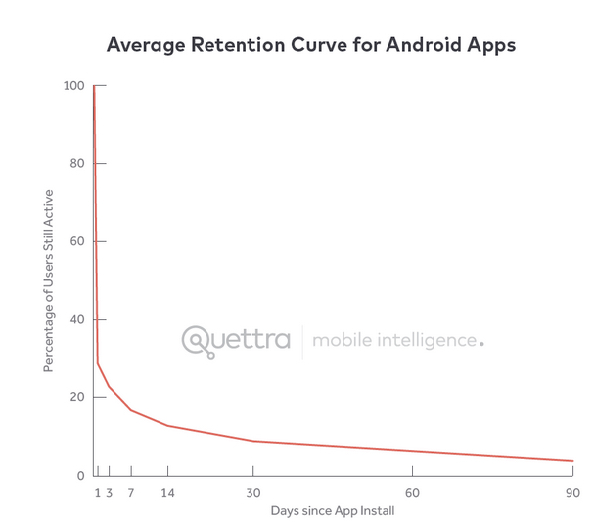Mobile app ecosystem is an ever-evolving space. In 2015, the mobile app industry was lot different than what it is today. This applies to app analytics as well.
The traditional mobile metrics that were considered highly significant then are trivial for app developers today. Today application providers prefer to embed analytics within their app to track the right metrics. It is crystal clear that trends are changing in app analytics industry.
The day of measuring an app’s success simply by the install, ratings and uninstall figures are long behind us. In 2016 relying only on these metrics will badly affect your revenue targets.
So, then which metrics should mobile app developers be paying attention to in 2016?
To make better app related decisions, we here at GoodFirms have identified few metrics that you should be tracking this year:
-
User Acquisition Metrics
This has always been and continues being a vital metric in app analytics this year as well.
This metric gives app developers details about the medium through which app is acquiring users – organic search, paid ads, or in-app referrals. Getting detailed information about the channels will help them leverage the appropriate ones to acquire new users at lower cost.
Apart from the source, this report gives information about the operating system used by users, their geographic location, networks being used by them and the app versions downloaded by them. This app analytics report can help app developers decide about their expansion plans; for instance the demographic or geographic location they must target next to earn more revenues from their app.
-
Engagement Metrics
In app analytics, it’s no secret that download figure provides very little information to app developers. The real information is gained by analyzing the current active user base of the app.
On Web, you will find millions of articles on the list of engagement metrics that you should monitor. But which engagement metrics you must monitor, actually depends on your app. For instance, for an app like TripAdvisor frequency of use is more important rather than user session. Meanwhile, for candy crush, it is the number of visits, rather than the duration of user’s visits.
Here we talk about the engagement metrics which are important irrespective of the kind of app you’ve build:
a. Active Users
‘Active Users’ are the unique amount of users who have opened the app in a selected time period. This metric will give you insight about user’s interest.
If the number of ‘active users’ is as per your expectations, your strategies are in place. But if the number falls below your expected goal, customers are either not opening your app after downloading it or are uninstalling it. The reason behind this could be anything from bad user experience to not meeting users’ expectations to not finding the app engaging.
After gaining insights from your loyal active user base, draw an actionable strategy to improve engagement with app users and to convert non-active users to active ones.
b. Crash Report
No, this is not the uninstall figure. But this report can guide you to do the right mobile math and indicate why your uninstall rate is towering north!
It is important for mobile app developers to get insights into how, why and when their app crash. An app crash can cause loss of data or interruption in user’s experience, thereby causing them frustration. According to reports, no more than 16% of users will try crashing app more than twice. From this, it is apparent, that if your app crashes frequently, users will uninstall your app from their smartphones.
There are many crash reporting tools like Crashlytics, Instabug or Parse available in market today which can be used to know which issues in the app require immediate attention.
-
Monetization Metrics
Below we have talked about few monetization metrics that are gaining importance this year.
a. Average Revenue Per User (ARPU)
ARPU is one of the most important monetization metric in app analytics. It is also used to calculate customer lifetime value (LTV) – another key metric for any app.
It is the average revenue you generate from each user of your application. It is calculated by dividing the revenue your app generates in a month by a total number of users for that particular month. ARPU must be calculated for paid installs, organic installs and total (free and paid) installs to change and improve your app’s monetization strategy if required.
b. CPI and CPLU
The ‘Cost per Install’ refers to the actual cost you paid for enticing a potential customer to install your app. The ‘Cost per Loyal User’ metric refers to the cost of acquiring an active user- the one who launches your app at least three times.
According to a report from BI Intelligence, cost-per-install on iOS was going up by 59% year over year and the CPLU was soaring 33%.
c. Retention
Retention continues to be one of the biggest challenges faced by app developers.
According to Quettra study, average android app loses 77% of its users in the first three days of installation.

Retention analysis will help gauge what’s working and what not in your app. While user engagement metric gets insight into how long a customer spends time within your app, retention metric helps track how often users visit your app.
Good user experience, great app performance, and engaging content drive app user retention, on the other hand, if done poorly or made deadly mistakes while creating an app, will cause users to uninstall your app.
Summary
If you are not monitoring the metrics listed above- don’t worry your competitors are! Tracking, monitoring and analyzing the right metrics is the key to app success.
Which app metrics are you monitoring to improve your app performance? Share with us below in the comment section.



